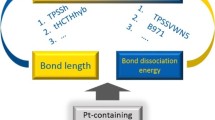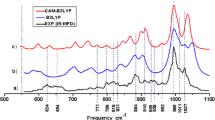Abstract
Noble gas chemistry is fascinating because noble gases can make formal chemical bonds with metal ions, despite their closed electronic configuration. Argon–metal ion complexes are particularly interesting since their bonding is halfway between dispersion and covalent interactions. Although many metal ion–noble gas complexes have been synthesized, there are still disagreeing theoretical descriptions about their bonding, which is not yet fully understood. Accurate experimental data are important as solid reference for theoretical methodologies, but such data are currently scarce for complexes of a metal ion with noble gas atoms. We measured infrared spectra of MArn+ (n = 3–5; M = Au, Ag, Pd) complexes and used these spectra as benchmark data for different theory levels within the density functional theory formalism. Several basis sets, exchange–correlation functionals, and the inclusion of dispersion corrections were considered. The agreement between the measured spectra and the calculations strongly depends on the applied level of theory. Functionals of a higher level of complexity do not consistently provide a better agreement with the experiment; this is particularly the case for the B3LYP hybrid functional that performs worse than the PBE GGA functional. On the other hand, the inclusion of dispersion corrections and the use of a large basis sets are crucial for a good description of the interaction between M+ and argon atoms.






Similar content being viewed by others
References
Pan S, Jana G, Merino B, Chattaraj PK (2019) Chem Open 8:173–187
Grochala W (2007) Soc Rev 36:1632–1655
Kapur S, Müller EW (1977) Surf Sci 62:610–620
Pyykkö P (1995) J Am Chem Soc 117:2067–2070
Read JP, Buckingham AD (1997) J Am Chem Soc 119:9010–9013
Bellert D, Breckenridge WH (2002) Chem Rev 102:1595–1622
Belpassi L, Infante I, Tarantelli F, Visscher L (2008) J Am Chem Soc 1303:1048–1060
Bauschlicher CW Jr, Partridge H, Langhoff SR (1990) Chem Phys Lett 165:272–276
Burda JV, Runeberg N, Pyykkö P (1998) Chem Phys Lett 288:635–641
Taketsugu Y, Taketsugu T, Noro T (2006) J Chem Phys 125:154308
Walker NR, Reynard LM, Gerry MCL (2002) J Mol Struct 612:109–116
Zhang P, Zhao Y, Hao F, Song X, Zhang G, Wang Y (2009) J Mol Struc-Theochem 899:111–116
Eliav E, Kaldor U, Ishikawa Y (1994) Phys Rev A 49:1724
Pyykkö P (1988) Chem Rev 88:563–594
Pyykkö P (2004) Angew Chem Int Ed 43:4412–4456
Martini P, Kranabetter L, Goulart M, Rasul B, Gatchell M, Scheier P, Echt O (2019) Phys Chem A 123:9505–9513
Mahmoodi-Darian M, Martini P, Tiefenthaler L, Kočišek J, Scheier P, Echt O (2019) J Phys Chem A 123:10426–10436
Ngan VT, Janssens E, Claes P, Fielicke A, Nguyen MT, Lievens P (2015) Phys Chem Chem Phys 17:17584–17591
Shayeghi A, Johnston RL, Rayner DM, Schfer R, Fielicke A (2015) Angew Chem Int Ed 54:10675–10680
Shayeghi A, Schäfer R, Rayner DM, Johnston RL, Fielicke A (2015) J Chem Phys 143:024310
Ferrari P, Hou G-L, Lushchikova OV, Calvo F, Bakker JM, Janssens E (2020) Phys Chem Chem Phys 22:11572–11577
van der Tol J, Jia D, Li Y, Chernyy V, Bakker JM, Nguyen MT, Lievens P, Janssens E (2017) Phys Chem Chem Phys 19:19360–19368
Lushchikova OV, Huitema DMM, López-Tarifa P, Visscher L, Jamshidi Z, Bakker JM (2019) J Phys Chem Lett 10:2151–2155
Ghiringhelli LM, Levchenko SV (2015) Inorg Chem Commun 55:153–156
Goldsmith BR, Florian J, Liu J-X, Gruene P, Lyon JT, Rayner DM, Fielicke A, Scheffler M, Ghiringhelli LM (2019) Phys Rev Mater 3:016002
Gruene P, Rayner DM, Redlich B, van der Meer AFG, Lyon JT, Meijer G, Fielicke A (2008) Science 321:674–676
Ghiringhelli LM, Gruene P, Lyon JT, Rayner DM, Meijer G, Fielicke A, Scheffler M (2013) New J Phys 15:083003
Mancera LA, Benoit DM (2013) Phys Chem Chem Phys 15:1929
Pan S, Saha R, Mandal S, Chattaraj PK (2016) Phys Chem Chem Phys 18:11661–11676
Jamshidi Z, Eskandari K, Azami SM (2013) Int J Quantum Chem 113:1981–1991
Grabowski SJ, Ugalde JM, Andrada DM, Frenking G (2016) Chem Eur J 22:11317–11328
Zeng T, Klobukowski M (2008) J Phys Chem A 112:5236–5242
Yousef A, Shrestha S, Viehland LA, Lee EP, Gray BR, Ayles VL, Wright TG, Breckenridge WH (2007) J Chem Phys 127:154309
Lang SM, Claes P, Cuong NT, Nguyen MT, Lievens P, Janssens E (2011) J Chem Phys 135:224305
Ferrari P, Vanbuel J, Li Y, Li T, Janssens E, Lievens P (2017) Modifications of gas aggregation sources: the double laser ablation source approach. In: Gas aggregation synthesis of nanoparticles. Weinheim, Wiley-VCH, pp 57–78
Fielicke A, Kirilyuk A, Ratsch C, Behler J, Scheffler M, von Helden G, Meijer G (2004) Phys Rev Lett 93:023401
Bakker JM, Lapoutre VJF, Redlich B, Oomens J, Sartakov BG, Fielicke A, von Helden G, Meijer G, van der Meer AFG (2010) J Chem Phys 132:074305
Valiev M, Bylaska EJ, Govind N, Kowalski K, Straatsma TP, Van Dam HJJ, Wang D, Nieplocha J, Apra E, Windus TL, de Jong WA (2010) Comput Phys Commun 1181:1477
Perdew JP, Ruzsinszky A, Tao J (2005) J Chem Phys 123:062201
Perdew JP, Burke K, Ernzerhof M (1996) Phys Rev Lett 77:3865
Tao J, Perdew JP, Staroverov V, Scuseria GE (2003) Phys. Rev. Lett. 91:146401
Becke AD (1993) J Chem Phys 98:5648
Vydrov OA, Scuseria GE (2006) J Chem Phys 125:234109
Goerigk L, Grimme S (2014) WIREs Comput Mol Sci 4:576–600
Weigend F, Ahlrichs R (2005) Phys Chem Chem Phys 7:3297–3305
Grimme S, Ehrlich S, Goerigk L (2011) J Comput Chem 32:1456–1465
Lu T, Chen F (2012) J Comput Chem 33:580–592
Mardirossian N, Head-Gordon M (2017) Mol Phys 115:2315–2372
Neese F (2012) Rev Comput Mol Sci 2:73
Jamshidi Z, Lushchikova OV, Bakker JM, Visscher L (2020) J Phys Chem A 124:9004–9010
Grimme S (2011) WIREs Comput Mol Sci 1:211–228
Raghavachari K (2000) Theor Chem Acc 103:361–363
Li X-Y, Cao X, Zhao Y (2009) J Phys B At Mol Opt Phys 42:065106
Acknowledgements
This work has been supported by the KU Leuven Research Council (Project C14/18/073) and by the CALIPSOplus project, under the Grant Agreement 730872 from the EU Framework Programme for Research and Innovation HORIZON 2020. LDC is supported by King's College London through the NMS Faculty Studentship Scheme. PF acknowledges the Research Foundation—Flanders (FWO) for a postdoctoral grant. The work has been performed under the Project HPC-EUROPA3 (INFRAIA-2016-1-730897), with the support of the EC Research Innovation Action under the H2020 Programme; in particular, the authors gratefully acknowledges the support of the Physics Department at King’s College London and the computer resources and technical support provided by EPCC at The University of Edinburgh. We thank the financial support offered by the Royal Society (No. RG 120207) via the membership of the UK's HEC Materials Chemistry Consortium, which is funded by the EPSRC (EP/L000202). We are grateful to the UK Materials and Molecular Modelling Hub for computational resources, which is partially funded by EPSRC (EP/P020194/1). This work used the ARCHER UK National Supercomputing Service. We gratefully acknowledge the Nederlandse Organisatie voor Wetenschappelijk Onderzoek (NWO) for the support of the FELIX Laboratory and thank the FELIX staff.
Author information
Authors and Affiliations
Corresponding author
Additional information
Publisher's Note
Springer Nature remains neutral with regard to jurisdictional claims in published maps and institutional affiliations.
Published as part of the special collection of articles “Festschrift in honor of Fernand Spiegelmann”.
Rights and permissions
About this article
Cite this article
Delgado-Callico, L., Ferrari, P., Bakker, J.M. et al. Benchmarking density functional theory methods for modelling cationic metal–argon complexes. Theor Chem Acc 140, 38 (2021). https://doi.org/10.1007/s00214-021-02734-z
Received:
Accepted:
Published:
DOI: https://doi.org/10.1007/s00214-021-02734-z




